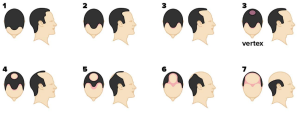FAQs
Genes responsible for hair loss make follicles vulnerable to the hormone dihydrotestosterone (DHT). At a certain stage in our lives, the follicles fail to grow normal hair thickness, resulting in thin strands of hair that give the effect of overall thinning hair. Later, the follicles cease producing any hair at all, leading to baldness. Your hair care methods do not cause hair loss, and products marketed as baldness cures have a limited ability to replace your balding spots with new hair. And when you stop using them, the results stop, too.
Fortunately, hair transplantation can replace your hair with sufficiently good results. It is the only proven method that gives you functioning hair follicles, allowing you to enjoy your new hair with confidence.
In general, any male or female who has thinning and/or balding areas of the head due to a non-scarring form of hair loss, and who has an adequate donor supply, is a candidate for this procedure. This procedure is most often elected to treat male pattern hair loss. It is also indicated for limited treatment of female pattern hair loss. Hair transplantation is also very useful in addressing scarring to the hair bearing scalp, whether due to previous plastic surgery or trauma.
It is very important that patients understand that only a trained, experienced Hair Transplant Surgeon should be trusted to reliably and accurately assess if you are a suitable surgical candidate. The physician will consider such factors as your age, family history, your individual hair loss pattern, future loss expectations, the color and curl of your hair and whether or not you have sufficient donor supply, to come up with a transplantation plan that is appropriate for you.
The best candidates for hair transplants are men who are generally healthy, have a robust supply of remaining donor hair, and positive attitude about surgery. While there is no age requirement, it’s typically better to be slightly further along in your hair loss pattern, meaning men younger than 25 are not typically the best candidates.
Yes, Dr. Ross will perform both harvesting and recipient site making.
All consultations are performed by Dr. Ross. We do not utilize “sales staff” or “consultants.”
Yes (FaceTime, WhatsApp and Zoom)
A transplantation of 2,000 grafts takes approximately 8 hours, including harvesting the donor area, dissecting the grafts and implantation. For “mega sessions” of up to 3,500 grafts, could take up to 10 hours. This approach minimizes the number of surgeries required to achieve the desired result.
For most people, this is one of the most important questions. The cost is determined by how much work you want to have done, and ultimately, the number of grafts you have available for the session. We try to make this procedure as affordable as possible.
The size of your combined follicular unit grafting depends upon several factors: 1, Your hair color relative to the color of the skin of your scalp. The closer the colors, the larger the combined follicular unit grafting can be. 2, Your hair shaft diameter. The larger the diameter, the smaller the combined follicular unit grafting should be because the smaller will be the number of hairs that will appear unnaturally pluggy. 3, The final density to by obtained. The lower the final density that is the goal, the smaller the combined follicular unit grafting should be. In Nature, usually but not always, as the hair becomes more sparse, the number of hairs per cluster becomes smaller. The hair shafts are also becoming more miniaturized as the hair becomes more sparse. Inasmuch as we cannot easily miniaturize the hair shafts, we would want to tend toward lower numbers of hairs per graft to lower the hair volume defined by each graft. 4, The proximity to an edge of the transplant. A larger combined follicular unit grafting (eg. 4 to 6 hairs) should not be placed immediately behind the micrografts. Smaller combined follicular unit graftings should be used to provide a more smooth gradient of hair density.
-Graft is a unit of hairs. Each graft can contain anywhere between one & four hair follicles.
Yes. This surgical restoration takes hair from the back of your head from an area called the donor area. Donor hair is very resilient to the balding process. As such, it makes excellent hair to be used for transplantation.
The grafts take approximately 3 months to begin to grow. Patients generally see their final results in 10 to 12 months.
-Stem Cells
-PRP Platelet-rich plasma
-Exosomes
-Alma Ted
The ARTAS® robotic hair restoration device is an advanced, minimally invasive hair transplant system that uses Artificial Intelligence (AI) technology to deliver precise, natural-looking results without leaving a linear scar. Using advanced image-guided robotics, ARTAS® can precisely analyze and dissect the best grafts from your donor area.

